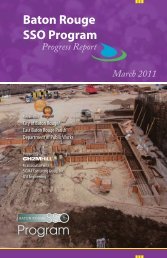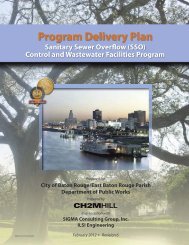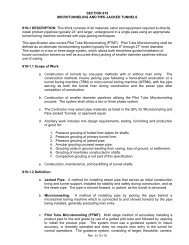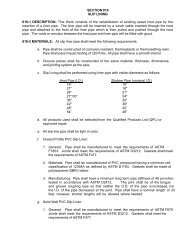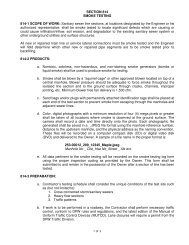Contents
Construction Management Plan - Baton Rouge Department of Public ...
Construction Management Plan - Baton Rouge Department of Public ...
- No tags were found...
Create successful ePaper yourself
Turn your PDF publications into a flip-book with our unique Google optimized e-Paper software.
• Do not work on scaffolds covered with snow, ice, or other slippery material or work on<br />
scaffolds during storms or high winds unless personal fall arrest systems or wind screens are<br />
provided and the competent person determines it is safe to remain on the scaffold.<br />
2.2.23 Sewage/Biosolids<br />
Although CH2M HILL employees are not expected to come in direct contact with sewage, staff may<br />
be downwind from biosolids spraying operations. Biosolids can contain bacteria, viruses, protozoa,<br />
and helminthes (parasitic worms), all of which can cause disease. Fecal coliform and other<br />
pathogens associated with sewage and biosolids are usually associated with self-limited<br />
gastrointenstinal illness.<br />
There is also the potential for the presence of Hepatitis A virus. Exposure to Hepatitis A virus<br />
through ingestion of dust could occur from high airborne levels of particles, or accumulations of<br />
dust on surfaces that are subsequently transferred from hand to mouth.<br />
Employees working on this project will be offered a Hepatitis A vaccination. A Hepatitis A<br />
vaccination fact sheet from the CH2M HILL Occupational Physician is included in Attachment 4,<br />
and a Hepatitis A fact sheet from the CDC is included in Attachment 5.<br />
Tetanus vaccines are also offered to CH2M HILL employees who work around and are exposed to<br />
raw sewage. Therefore, it is recommended that project personnel have a current tetanus<br />
vaccination.<br />
The following basic hygiene and safety practices are required for workers handling or exposed to<br />
biosolids.<br />
• Wash hands thoroughly with soap and water after contact with biosolids.<br />
• Avoid touching face, mouth, eyes, nose, genitalia, or open sores and cuts while working with<br />
biosolids.<br />
• Wash your hands before you eat, drink, smoke and before and after using the bathroom.<br />
• Eat in designated areas away from biosolids handling activities.<br />
• Do not smoke or chew tobacco or gum while working with biosolids.<br />
• Use barriers between skin and surfaces exposed to biosolids.<br />
• Remove excess biosolids from footgear prior to entering a vehicle or a building.<br />
• Keep wounds covered with clean, dry bandages.<br />
• Flush eyes thoroughly, but gently, if biosolids contact eyes.<br />
• Change into clean work clothing on a daily basis and reserve footgear for use at work site or<br />
during biosolids transport.<br />
• Do not wear work clothes home or outside the work environment.<br />
• Use gloves to prevent skin abrasion<br />
2.2.24 Stairways & Ladders<br />
(Reference CH2M HILL SOP HS-214, Stairways and Ladders)<br />
• Stairway or ladder is generally required when a break in elevation of 19 inches or greater exists.<br />
• Personnel should avoid using both hands to carry objects while on stairways; if unavoidable,<br />
use extra precautions.<br />
GNV310133632156.DOC/090840008 A-27



